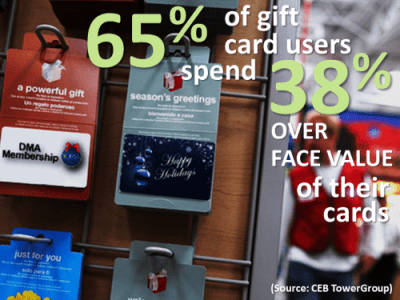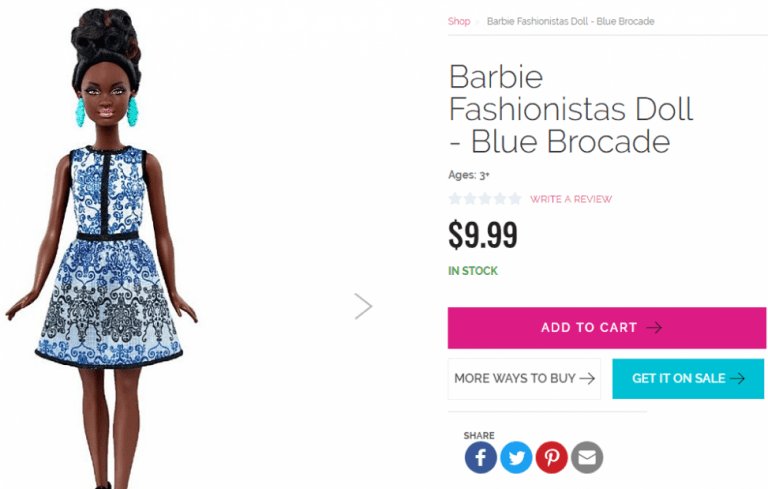If 93% of your customers asked to buy a product from you, and you knew that this specific product tends to lead to additional purchases at your store, would you walk away from the opportunity? According to research after research, if you don’t offer Gift Cards at your store, that’s exactly what you’re doing.
“93% of American consumers have purchased a Gift Card” and “the total volume of Gift Cards is projected to reach $160 billion by the end of 2018,” reports Gift Card Granny.

Source: Gift Card Granny
Gift Cards are growing ever more lucrative for Shopify stores.
Not only have Gift Cards “been the most-asked-for gift item” for 8 years in a row, but “many consumers spend more than the value of the Gift Card” when they go to redeem their present, reports Wirecard.
A lot more.
In fact, according to the International Dermal Institute, “72% of customers will spend more than the value of their card” – often “20% more than his/her Gift Card value.” And that’s a conservative number.
Another research, which we’ll mention below, concluded with even more promising numbers.
But if you’re ready to integrate this new revenue source in your store, how do you make sure your Shopify Gift Card program is indeed as lucrative as the statistics promise?
We’ve got you covered with 5 key steps that will set you up for success.
Step #1: Get Clear on Why Customers Need to Buy Your Specific Shopify Gift Card Over a One-Size-Fits-All Solution Like an Amazon Gift Card
Buying gifts for someone else is not easy, and even though a Gift Card makes it easier, choosing the right store for your loved one is still a challenging task.
It’s easy to see why many people end up going for the easy solution and get an Amazon Gift Card, where the receiver can choose practically anything they want from an almost unlimited number of categories.
After all, what’s the difference between the camera you sell and the camera Amazon sells, except for the fact Amazon sells a wider range of equipment, at a wider range of prices, and – again – a gazillion other types of products?
According to successful entrepreneur Marie Forleo, it’s about differentiation.
In the video below, she recommends focusing on the purpose of your business. What your business stands for, who your ideal clients are, and what frustrates you in your industry – so you can build a more unique brand.
For example, instead of offering a relaxing and therapeutic massage service to everyone, Forleo recommends focusing on busy moms, and digging deeper into what a relaxing and therapeutic experience means to them – like getting time alone, away from the kids.
Check out how Forleo suggests positioning this service and writing marketing copy to make sure these busy moms choose you overgeneralized marketplaces:
Source: Marie Forleo via YouTube
Want to see this differentiation strategy in action? Check out how Dick’s Sporting Goods sells sports apparel and equipment in the following devio.
It doesn’t talk about how great its products are, but about the transformation busy moms can make in their lives if they just take a moment for themselves – with the help of its products.
Source: Dick’s Sporting Goods via YouTube
Differentiate Your Gift Card
But it doesn’t stop there.
Once you’ve differentiated your brand, it’s time to differentiate the Gift Card buying and receiving process in your store.
You see, most stores optimize the buying process for people who buy for themselves, but neglect the emotional experience of buying a gift for someone else, a neglect that’s felt more intensely when buying Gift Cards.
That’s because, as the Journal of Economic Perspectives explains, “Gift Cards lack the sentimental value of a physical present and have similar properties of cash gifts, such as revealing the total amount spent.” Therefore, an easy way to stand out is to help the buyer add a personal touch, like an animation, photo or greeting – or even letting the buyer design the gift (say, choose the words and colors of a birthday mug).
An added bonus? That makes the buyer a co-creator of the gift, which increases the likelihood that she or he will finish the buying process with a credit card instead of with cart abandonment.
Even better? It helps you differentiate the Gift Card email to the gift receiver, as well as the landing page they’ll click to.
Use the personalization the buyer created, and maybe add visuals of balloons or other festive elements.
This will add an emotional aspect to an otherwise non-personal “free money card.” If your product helps strengthen the emotional connection between the buyer and the receiver, these positive emotions will come up for the receiver – likely a qualified customer – every time she or he needs the kind of products you sell.
Of course, in order to do this successfully in your store, you need to get clear on who your top customer sectors are, and what they need for you to successfully complete their purchases.
Step #2: Keep These 3 Top Customers in Mind When Developing a Long Term Shopify Gift Card Strategy
For your Shopify Gift Card program to be a success, you need to keep in mind how it could benefit your customers.
You need to identify their needs – and what could be stopping them from buying – so you can weave solutions into your strategy.
Here’s how to do it with 3 common customer segments of Gift Card programs.
When Your #1 Buyer is Not Your Typical Target Audience
Back in 2010, Inc magazine emphasized one of the main problems retailers face when they prioritize the gift market in their business – people who buy gifts in your store aren’t always your typical customer.
“One example of this is in the spa industry, which is dominated largely by female clientele.
However, many spa owners report that it is usually men who are buying spa gifts for women in their lives and need some directions about what to buy,” explains Inc.
When developing your Gift Card plan, come up with ways you can help the Gift Card buyer make a more successful purchase.
Develop guides that quickly explain how to choose the pros and cons of top options, a quiz about the receiver’s preferences and personality that ends up with the best present to buy for this type of person, or a gift hotline, where your gift experts – AKA customer service agents – can help them out.
Another option is to partner with influencers and create a package for Gift Cards around these influencers’ recommendations.
Imagine a son whose mom praises Martha Stewart all the time, and he runs into this video Steward did with Macy’s.
In this case, the video was created to promote the Martha Stewart Collection of home products in collaboration with Macy’s, but what if you could buy a Gift Card specifically for this collection? Wouldn’t it make the Gift Card purchaser’s life easier? Of course, the amount of investment depends on how much their purchase is worth it to you, but don’t just think of this month or this quarter.
Think of young adults whose friends keep having babies before they do and they don’t know what new parents need, or grandparents who haven’t kept up with technology, yet have multiple grandkids graduating high school and starting college within 5 years.
Or even that man who likes to stick to old habits and buys his partner the same present – a spa package, for example – every single year.
Make it easy for them to look good in the eyes of the gift receiver, and they’ll come back to buy more gifts.
The Gift Receiver is Your Getaway to Significant Revenue Growth
This happens to many of us.
We get a Gift Card, we log in to the store’s website and start browsing through products.
Temptation is everywhere, and with the “free money” in our Gift Card, it’s easy to add some extra dollars out of pocket and get that camera or guitar we’ve always wanted.
In fact, it’s so common, that “shoppers typically spend 38% over the face value of their Gift Card,” reports Retail TouchPoints.

Source: Data & Marketing Association
And according to the International Dermal Institute, “customers are 2.5 times more likely to buy something for full price if they pay with a Gift Card.” But, according to CBS News, “even if consumers manage to spend just a few dollars over, those dollars translate to millions in profits, company-wise.
And customers who come in just a few dollars under the card’s value are enticed to come back for a repeat visit, where they will surely need to spend more to exhaust the leftover funds on the card.” Therefore, if you provide digital Gift Cards, send a couple of reminders to gift receivers to encourage them to collect their gift.
Consider offering an additional incentive – like double discounts or participation in a giveaway just for people celebrating special occasions – to encourage them to come or log in to your store.
Just don’t overdo it. Remember that the gift receivers are not the one who gave you permission to email them.
Once they do log in or step into your store, it’s time to work your magic.
Hopefully, whoever chose this store for them did a good job qualifying them as great prospective customers for you.
That means they’re your people, you speak their language and you know what they need. They’re at your store in a good mood because they’ve come to collect a gift.
Give them the VIP experience so you can earn their business – and email address – for the long term.
Then There are People Who Buy Gift Cards for Themselves (and Almost Double Your Bottom Line)
According to Jason Wolfe, CEO of GiftCards.com, not everybody buys Gift Cards to celebrate a birthday, a milestone or a holiday of a loved one.
Some people buy Gift Cards for themselves.
To save money.
Source: Jason Wolfe via YouTube
In the video above, Wolfe explains that some people “are buying Gift Cards to… get discounts off of purchasing gas.
That’s what they do at grocery stores [too].
Some people redeem points or miles and they get Gift Cards.” If they buy a Gift Card worth $100 and only pay $85 – they save 15% on their purchases.
If they regularly buy at the same store, that could translate into hundreds or thousands worth of savings a year for a customer, but it could also benefit the store.
Say a customer does spend $85 to buy a $100 Gift Card for themselves.
That’s $85 they spent with you, instead of spending $45 today and $40 who knows when – or at which store.
According to Wirecard, survey respondents purchased two gifts card on average in the preceding year “because loyalty or reward points were offered.
Furthermore, a third of respondents ended up making a purchase at a particular store because an incentive was offered, even when they were not planning to do so.
And 40% spent more than originally planned because an incentive was offered.” Therefore, retailers need to be proactive and offer Gift Cards to everyday customers, even when there doesn’t seem to be any gift gifting opportunity in sight.
You could offer “customers a discount on their purchases when they also buy a Gift Card,” Wirecard suggests.
You could position it as giving a gift to themselves… and encourage them to remember you when they want to share the fun with loved ones on special occasions as well.
Step #3: Brainstorm Upsell and Cross-Sell Options
When a customer has made a Gift Card related decision and is ready to buy, it’s time for them to pull out the credit card and check out, right? Wrong.
When they’re ready to buy, it’s time to politely offer them to improve their purchase by adding a little more to it.
These days, technology offers so many ways to easily and quickly gather data, so you could offer a wealth of options to the right people along their customer journey.
For example, you can cross-sell a greeting card or a box to store the Gift Card.
You can cross-sell the Gift Card itself when people buy products for themselves, as we mentioned above.
You can also upsell a package of Gift Cards – say, for those looking for discounts, or for those young adults whose friends keep having babies.
You know they’re going to need your type of products again soon, so why not secure their purchase upfront? Alternatively, remember the husbands that buy spa packages for their partners? You could offer them an upsell to a more expensive, more luxurious experience for their spouses.
According to ConversionXL, a small portion of your audience (4.25%) will actually upgrade to the more expensive version because they’re not sure they’re making the right choice.
That could be especially true if they’re not the usual target audience of your kind of store.
But it could also be true for someone who got a Gift Card, and might be open to adding a little to this “free money” gift.
Let’s say your daughter got a $9.99 Gift Card for the official Barbie website.
She wants to buy a Barbie, and really likes this one…

… but it’s not the only Barbie she likes, so she’s not sure which one to get.
How unlikely is it that she’d be open to adding 6 extra dollars out of pocket – or asking you to add them – so she can get two dolls instead of one?

Or $13 extra, so she can get three dolls instead of one?

Source: Mattel
ConversionXL emphasizes that it’s worth it to develop upsell and cross-sell options for each of your customer sectors despite the small percentages who will opt in. “How significant would 4.25% of your customers spending an extra $20, $50 or $100 be for your bottom line? If [a] single product averages 1,000 customers/month, that means you’d be adding an extra $860-4,300 to sales every month.
By the end of the year, that’s an additional $10,320-51,600 on a single product,” or in our case, a single Gift Card type.
Step #4: Figure Out How to Keep the Relationship Going with Each Customer Sector Beyond the First Gift Card Purchase
As you can see, many customers who look for Gift Cards in your store can benefit from a more holistic – and sometimes a more long-term – experience with your store.
And as you can guess by now, it could be very beneficial for your store as well.
In fact, Clarity reports that “it is 50% easier to sell to existing customers than brand new customers,” so even “a 5% increase in customer retention can increase a company’s profitability by 75%.”

Source: Clarity
So whenever a customer comes to you for a Gift Card, make sure you get their email address, so you can keep in touch and preserve the relationship.
If they don’t know what to buy, give them a free guide or an online consultation in exchange for their email address.
If they redeem a Gift Card, offer an extra gift of your own, to celebrate their special occasion, in exchange for their email address.
If they buy a Gift Card for themselves to save on purchases, offer a free subscription to your VIP newsletter, where they can get access to exclusive special offers, only available for loyal customers like them.
Then make sure you follow up.
For example, if those grandparents with high school graduating kids do show up at your store, find out when their next grandkid graduates, and schedule an email to check in with them beforehand.
You could always suggest a little extra incentive to make sure the next grandkid also gets a Gift Card from your store.
Meanwhile, if this is a significant customer sector for you, you could stay in touch via a newsletter that teaches these grandparents about technology, so it’ll be easier for them to relate to their teenage grandkids’ world… and easier for them to consider a techie purchase for the next graduation, too.
To give you inspiration for the kind of content you can create, here are some grandmas who tried Snapchat:
Source: Obsev Entertainment via YouTube
No matter which customer sector you choose to prioritize, take time to choose products and Shopify Gift Card apps that are domain experts in the gifting industry and can gather customer data, build customer profiles, and give you in-depth insights – plus tools that help you offer more accurate deals to the right people at the right time, and automate the process.
Of course, in order to gain data, you need to do one more thing.
Step #5: Develop a Marketing Plan
You can have the best Gift Card program in the world, but if you don’t actually tell the world about it, nobody’s going to buy.
Now that you’ve got your Shopify Gift Card program strategy in place, it’s time to create a marketing strategy, so you can make some sales.
Use your home page, your newsletter and your social media channels to announce it to people who already love your store.
Publish guest posts on big sites or local news sites to get in front of audiences who don’t know you yet.
And consider collaborating with complementary companies.
If you sell cars, partner with insurance brokers or garages to offer tutorials – or even combined Gift Cards, which you can all promote to your customers.
They’ll be exposed to your customers, and you’ll be exposed to theirs.
Want Next Year to Be More Profitable? Don’t Wait and Start Building Your Shopify Gift Card Program
Building a Gift Card program isn’t easy, but it’s worth your effort, so get started as soon as possible. Remember that it takes time to build it and implement it.
It takes time to market.
It takes time to test what works and what doesn’t with your specific audience.
Start today. Start small. Take a step forward. Test something. Make a change. Test again.
The Shopify apps and products available today make it really easy to get started, gather data, offer significantly more value to your customers, plus automate the process.
And it’ll slowly get even easier, it’ll slowly work better, and it’ll gradually become more and more profitable.
And when it does, go to somebody else’s store and buy your team some Gift Cards to share the wealth, and share the joy.
Yair Miron is the Founder and CEO of Rise.ai, a startup company in the online gifting world.
Rise.ai has created the top data-driven, gifting apps in Shopify.
Rise.ai takes care of every aspect of the gift purchase and creates an ideal gifting experience for both online stores and shoppers.



